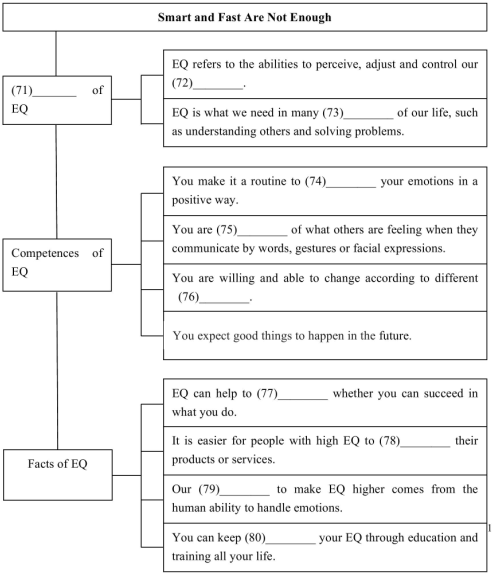题目内容
10.Shi Jianfei is a college student at Beijing Information Science and Technology University.He met with an academic problem during the summer vocation but it took him a lot determination to finally approach his professor to solve the problem.To his surprise,the meeting turned out to be quite pleasant.But only few students turn to their professors to ask for advice in solving problems or discuss academic topics with them.According to an investigation of 2,636college students conducted by MyCOS,a Beijing-based consultancy (咨询公司),more than a third of them contact their,professor less than once a year.
Although most students and teachers are willing to communicate with each other,it seems that an effective communication system is absent.Shi says,"Communication usually takes place in class or between classes,because it's difficult to get in touch with professors at any other time.University professors always look very busy."
However,from the teachers'perspective,students are too cautious about communicating with professors."They're worried about asking questions for they think they may leave a bad impression,"says Du Xiguang,professor of chemistry at Northeast Normal University.Du created a QQ group in which students can discuss various issues with him,ranging from academic topics to personal problems."I find they are very talkative in this group.But if they talk to me in person,they're shy and nervous,"he says.
Wu Qian,22,an English major at Tsinghua University admits that when she meets with problems she prefers talking to her classmates and upper-classmen."I think many students are too shy and passive,myself included.I feel more comfortable communicating with my classmates,"she says.
Du also says that the shyness of many students to a change lies in different teaching styles.In primary school,Chinese students get used to talking with their teachers because they're like"nannies"who not only teach,but also watch out for their students'personal development.
"In college,such communication isn't compulsory any more and students aren't pushed to discuss their ideas with professors,"says Du."The real problem is that students aren't yet ready to engage in adult conversation with professors.Some of them just expect professors to explain facts and help them prepare for exams,like in high school."
55.What does Paragraph 2talk about?B
A.The reason why the communication is little.
B.The present situation of communication.
C.The background of the phenomenon.
D.The details of the phenomenon.
56.What's the real reason why Shi Jianfei didn't turn to his professor for help immediately meeting with an academic problem?C
A.An effective communication mechanism is absent.
B.It's difficult to get in touch with professor.
C.He is too shy and passive.
D.Communication isn't compulsory any more.
57.The underlined word"nannies"is closest in meaning toA.
A.nurses B.gardeners C.friends D.leaders
58.In which way does the author present the passage?D
A.By giving some dialogues between students and teachers
B.By giving some specific examples of students and teachers
C.By interviewing different students and teachers
D.By listing some facts and opinions of students and teachers.
分析 文章讲述了大学生与教授之间的交流比较少,并陈述了大学师生之间加强沟通的必要性.
解答 55.答案 B 细节理解题 根据But only few students turn to their professors to ask for advice in solving problems or discuss academic topics with them.可知目前大学生与教授之间的交流比较少,故答案为B
56.答案 C.细节理解题 第四段出现了有效沟通措施,所以不选A项;B项In Paragraph 3"Communication usually takes place in class or between classes,because it's difficult to get in touch with professors at any other time,"he says."University professors always look very busy."学生们通常只有在课上或是课间时才会和老师有互动,因为在其他时间,你很难联系上教授.大学教授们看上去总是很忙.这并不是原因.根据But if they talk to me in person,they're shy and nervous表明学生面对教授时会害羞和紧张,故选C
57.答案 A 词义猜测题 根据常识和In primary school,Chinese students get used to talking with their teachers because they're like"nannies"who not only teach,but also watch out for their students'personal development.可知,"nannies"是保姆的意思,故答案为A
58.答案 D 通读全文可知,文章是通过列举事实和不同人的观点来展开的,故答案为D
点评 1、要想做好科普英语阅读理解题,同学们就要注意平时多读科普知识类文章,学习科普知识,积累常见的科普词汇,从根本上提高科普英语的阅读能力.
2、要熟悉科普类文章的结构特点.科普类文章一般由标题(Head line),导语(Introduction),背景(Back ground),主体(Main body)和结尾(End)五部分构成.标题是文章中心思想高度而又精辟的概括,但根据历年的高考情况来看,这类阅读理解材料一般不给标题,而要同学们选择标题.导语一般位于整篇文章的首段.背景交待一个事实的起因.主体则对导语概括的事实进行详细叙述,这一部分命题往往最多,因此,阅读时,同学们要把这部分作为重点.结尾往往也是中心思想的概括,并与导语相呼应,命题者常在此要设计一道推理判断题.
3、在进行推理判断时,同学们一定要以阅读材料所提供的科学事实为依据,同时所得出的结论还应符合基本的科普常识.

| A. | once | B. | after | C. | unless | D. | while |
| A. | anything,everything | B. | nothing,everything | ||
| C. | everything,anything | D. | none,everything |
| A. | so that | B. | in case | C. | as though | D. | even if |
